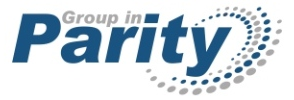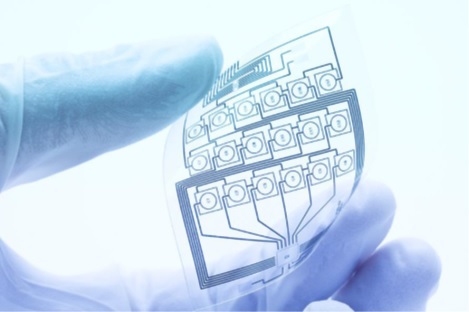 Expand Your Horizon with Lumitronix Solutions
Expand Your Horizon with Lumitronix Solutions
Group in Parity, LLC is pleased to be collaborating with LUMITRONIX® LED-Technik GmbH of Germany for market response and development in North America. We are thrilled with the opportunity to serve a variety of markets and applications, and to explore with customers the projects previously not possible or imagined.
Please contact us or Schedule an Appointment and see for yourself at Light+Building, Frankfurt Germany. The following is based on original Lumitronix press release issued in 2019.
Plasma Metallization by Lumitronix® : Using paper and PET as printed circuit board
Copyrights © LUMITRONIX® 2019-2020
In cooperation with its technology partners, the Swabian LED company Lumitronix succeeded in equipping plasma-metalized flexible printed circuit boards with electronic components. This is based on the one-of-a-kind process of plasma metallization. The no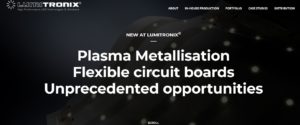 vel technology from the field of medical engineering turns a plurality of materials into electrically conducting and solderable printed circuit boards that were not suitable for an assembly with electronic components up to this point in time.
vel technology from the field of medical engineering turns a plurality of materials into electrically conducting and solderable printed circuit boards that were not suitable for an assembly with electronic components up to this point in time.
Plasma metallization : more than 10 years of research and development
“Within the framework of this special type of metallization, a patented plasma spray head is used to spray a conductive metal – mostly copper – in the form of a powder under high atmospheric pressure onto the basic material coated with silver paste.
Simultaneously, the copper is fused by a very hot plasma beam of 10,000-50,000° C whereby a connection with the silver substrate is being formed. This metallization process provides for a conductive basic material and ensures that it can be soldered and ultimately equipped with electronic components in the further course of production”, says Christian Hoffmann, CEO of Lumitronix. 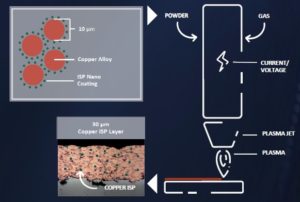
This unique technology is based on more than 10 years of research and development. This game-changing process has its origins in the field of medicine, where implants or prostheses have been sprayed with bone powder for quite some time already such that these grow together with the body’s tissue in an enhanced manner and are not considered as foreign objects and possibly rejected. This know-how was transferred to the field of electronics and, with plasma metallization, a process was created that will be used as the standard from now on.
New and affordable basic materials as printed circuit boards
When compared to the standard material polyimide, forming the basis for the majority of all flexible printed circuit boards available on the market, the innovative process of plasma metallization results in multiple new and affordable basic materials for printed circuit boards.
So far, solderable paper FPCs (FPC = Flexible Printed Circuit) are a novelty however, as a consequence of this new Lumitronix technology we offer a plurality of applications. They are affordable, have no diffusion barrier and are thus suitable for large-scale applications such as wallpapers or advertising spaces.
PET may also serve as a basic material for FPCs. This plastic material is cheaper than polyimide, is characterized by a very good strength, a high resilience, and a low weight. When coated with a thin aluminum layer, which is rendered solderable via plasma metallization, the PET FPCs may be equipped with components. Furthermore, PET is transparent and can therefore be applied to glass surfaces, for instance. Illuminated glass facades of multi-story buildings, windows, or glass doors are conceivable.
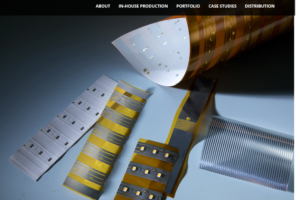 Moreover, aluminum FPCs coated with copper may be used in order to achieve both cost savings and a weight reduction when compared to pure copper FPCs. Thanks to 100 µm thick aluminum, the FPCs are also provided with a high current load capacity and may be used for interior and exterior applications. Since the surface of aluminum is not solderable without further ado, it has not been used in the field of flexible printed circuit boards up to now.
Moreover, aluminum FPCs coated with copper may be used in order to achieve both cost savings and a weight reduction when compared to pure copper FPCs. Thanks to 100 µm thick aluminum, the FPCs are also provided with a high current load capacity and may be used for interior and exterior applications. Since the surface of aluminum is not solderable without further ado, it has not been used in the field of flexible printed circuit boards up to now.
Advantages of plasma metallization
When compared to the standard process utilized for printed FPCs, whereby the basic material printed with non-solderable strip conductors – e.g. made of aluminum – is coated by means of a conductive adhesive with a high silver content, the plasma metallization method is much cheaper. The high silver content used within the framework of the conventional process results in significantly higher financial expenditures and additionally is complex. Furthermore, it is not that reliable, since the conductivity ultimately depends on temperature and moisture.
Another advantage of plasma metallization is that the high current – more than 10 A, preferably 50 A – and the low voltage – preferably 50 V – used within the framework of the process of irradiation prevent the complete breaking of the molecule chains of the coating material. However, the exclusion of oxygen results in the prevention of a direct oxidation of the coating material within the plasma beam. 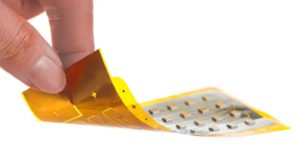
Therefore, high energies for starting the chemical reaction may be introduced into the coating material, which is why Lumitronix’s novel method is particularly suitable for continuous, industrial coating processes with high coating rates.
Mass production with Lumitronix
Series production of the flexible printed circuit boards are performed on a new Lumitronix in-house production line. The new flexible strip production line is capable of equipping the basic printed circuit boards using the reel-to-reel process. Thanks to state-of-the-art machines and high processing speeds, production may be implemented on a large industrial scale.
The particularity of the flex line is that all possible flexible materials may be processed there. Starting with the standard flex material polyimide, via wallpapers or paper up to very affordable plastic (PET) substrates.
The Lumitronix production line allows for serially equipping basic material that is present in the form of reels. These reels are chucked at the beginning of the lines and tightened along the entire length by clamp supports – also referred to as hitch feeders – so that the further processes of coating with solder paste and equipping with LEDs and other components may be performed smoothly.
Upon the step of equipping, the flexible printed circuit boards are soldered in an infrared oven and then checked electronically and optically by a machine. Afterwards, the flexible printed circuit boards may be cut to individual lengths and different patterns, respectively, by oscillating blades. Additionally, a special printer allows for printing the flexible printed circuit boards in colors and therefore customizing these.
The advantages of flexible printed circuit boards
When compared to rigid printed circuit boards, FPCs are characterized by several advantages. Due to their flexible basic material, they can be used individually and due to their low weight, they additionally provide first and foremost luminaire manufacturers with more creative leeway. Furthermore, it is possible to implement whole new dimensions when it comes to the length. When compared to rigid printed circuit boards made of FR4 or aluminum, flex PCBs are cheaper and may be subjected to a higher dynamic und mechanical load without being damaged as a consequence.
Thanks to processing the FPCs in the form of reels with a length of 50 to 100 meters the storage and transportation expenditures are lower as well. Additionally, large-scale manufacturers benefit from this form of printed circuit boards, since they are able to further process these on their own production line immediately and in an automated manner.
Applications of the innovative technology
“As a matter of principle, this novel technology may be used to render any thinkable basic materials conductive and solderable. For instance, illuminated wallpapers are only one possibility for this innovative invention.
Metalized paper may first and foremost be used in the field of advertising in the form of postcards, letter paper, posters, or packages and equipped with light-emitting diodes and other electronic components,” says Hoffmann.
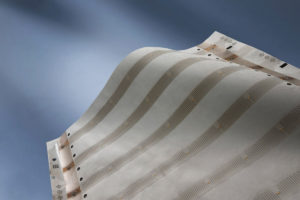
Large-area special applications may also be implemented. For instance, metalized paper or PET film equipped with LEDs may be used in order to produce huge illuminated placards or banners for exhibition stands that may simply be disposed of after having been used. A conductive surface may even be applied to functional textiles such as curtains, blinds, soft top cloths and then be equipped individually with LEDs and additional electronic components. The range of applications for the basic materials treated with plasma metallization is truly manifold.
Another option is rapid prototyping, within the framework of which strip conductors made of silver paint are printed to paper using an ink-jet printer, then plasma-metalized, and then equipped. The printing process is significantly easier and less complex when compared to the conventional etching process, with the latter being very complex and also cost-intensive specifically for small numbers.
Exclusive distribution by Lumitronix
The series production of the flexible basic materials as well as their resale are performed exclusively by the Lumitronix corporation that is positioned by years and years of experience in the field of LED technology, access to products of the leading LED und electronics manufacturers, as well as a large market penetration.
About Lumitronix
Lumitronix has been ranging amongst the leading specialists for LEDs und LED products for many years. As a competent partner for the industry, Lumitronix demonstrates a broad know-how from several industries. The Swabian company headquartered in Hechingen, Germany is certified according to ISO 9001 and furthermore is the official distributor of market-leading manufacturers of LED technology. However, Lumitronix is not only active in the field of distributing LED products, but also has in-house development and production departments working according to customer-specific requirements.
Quality Made in Germany.
